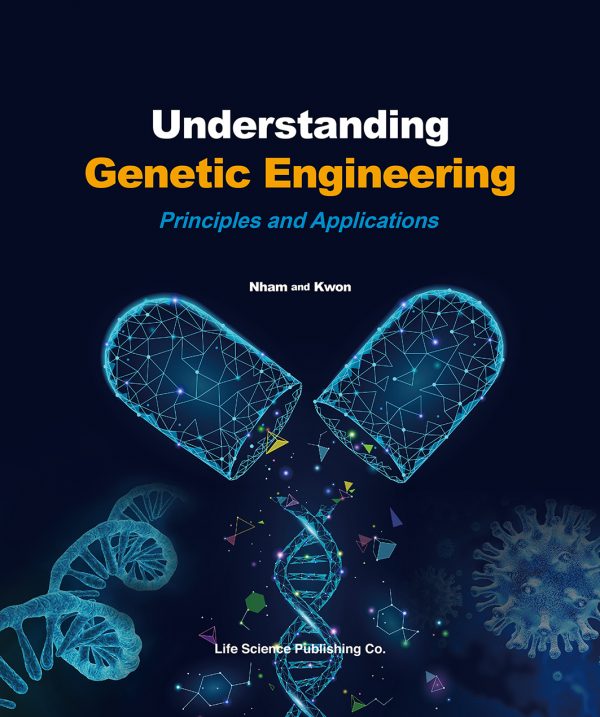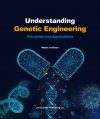Understanding Genetic Engineering
전자책은 Streaming 방식으로 판매됩니다. PDF다운은 저작권법상(불법) 안됩니다. E-book(전자책) 서비스를 무통장 입금을 통하여 이용하시는 경우 공휴일 및 연휴에 주문하신 경우에 한하여 결제진행이 지연될 수 있습니다.
0%
SALE

전자책은 Streaming 방식으로 판매됩니다. PDF다운은 저작권법상(불법) 안됩니다.
저희 홈페이지에서 제공해드리는 전자책 서비스는 스트리밍(Non-DRM)방식이므로 결제가 완료되면 따로 다운로드를 받지 않아도 바로 열람이 가능합니다.
그에따라 결제완료 후 단순변심에 의한 교환 및 환불이 불가능한 점 안내드립니다.
Contents in Brief
1 Overview of Genetic Engineering 1
2 Structure and Expression of Genes 14
3 Properties and Isolation of Nucleic Acids 42
4 Enzymes and Electrophoresis 60
5 Vectors 90
6 Construction of Recombinant DNA 114
7 Acquisition of Genes 142
8 Gene Analysis and Diagnoses 168
9 Genome Analysis and Genomics 200
10 Transcription Analysis and Control 252
11 Protein Purification and Analysis 292
12 Protein Engineering 324
13 Genetic Engineering of Microorganisms 372
14 Genetic Engineering of Animals 402
15 Genetic Engineering of Plants 444
16 Medical Application of Genetic Engineering 482
Glossary 513
Index 526
Contents
1 Overview of Genetic Engineering 1
1.1 What is Genetic Engineering? 2
1.2 The Birth and Development of Genetic Engineering 3
1.3 Applications of Genetic Engineering 7
A Look Back 1-1 The Speed of Biotechnology Development 10
A Closer Look 1-2 Birth of Artificial Cells and Its Significance 11
Summary 12
Review Questions 12
Further Reading 13
2 Structure and Expression of Genes 14
2.1 Nature of a Gene 16
- Chromosome Theory 16
- DNA as Genetic Material 16
1) Transformation Experiment: Griffith, 1928 17
2) In vitro Transformation Experiment: Avery, MacLeod, & McCarty, 1944 18
3) Blender Experiment with T2 bacteriophage: Hershey & Chase, 1952 18
2.2 Chemical Structure of Nucleic Acid 19
- Components of Nucleic Acid 20
- Chargaff’s Rule 20
- X-ray Crystallography Experiment 20
- DNA Double Helix Structure 22
1) Double Helix 22
2) Significance of the Double Helix 23
- Semi-Conservative Replication of DNA 24
2.3 Gene Expression and Regulation 26
- Genes and Proteins 26
- One-Gene One-Enzyme Hypothesis 27
- Central Dogma of Genetic Information 28
- Structure of a Gene 29
1) Structure of Prokaryotic gene 29
2) Structure of Eukaryotic gene 29
- Gene Expression 30
1) Transcription 30
2) Translation 31
- Regulation of Gene Expression 34
1) Transcription Regulation in Prokaryotic Cell 34
2) Regulation of Gene Expression in Eukaryotes 37
A Look Back 2-1 Historic Discovery of DNA Structure 27
A Closer Look 2-2 The RNA World 39
Summary 40
Review Questions 41
Further Reading 41
3 Properties and Isolation of Nucleic Acids 42
3.1 Properties of Nucleic Acids 44
- Denaturation and Renaturation of DNA 44
- Hybridization 45
- Stability of DNA and RNA 45
3.2 Extraction and Purification of Nucleic Acids 48
- Isolation of Plasmid DNA 48
- Extraction of Genomic DNA from Cells 50
1) Isolating Genomic DNA from Bacterial Cells 50
2) Isolating Genomic DNA from Animal Cells 51
3) Isolating Genomic DNA from Plant Cells 51
- Isolation of Phage DNA 52
- Isolation of RNA 53
1) General Properties of RNA Extraction 53
2) RNase Contamination and Removal 53
3) Total RNA Isolation Process 53
- Isolation of mRNA 55
- Precipitation and Storage of Nucleic Acids 55
- Measuring Nucleic Acid Concentration 56
A Closer Look 3-1 RNase, a very stable enzyme 46
A Closer Look 3-2 Ancient DNAs and Their Stability 47
Summary 58
Review Questions 58
Further Reading 59
4 Enzymes and Electrophoresis 60
4.1 Enzymes for Genetic Manipulation and Analysis 62
- Nucleases 62
1) DNA Exonuclease 62
2) DNA Endonucleases 64
3) RNase 65
4) Restriction Enzymes 65
5) Nuclease Systems for Genome Editing Molecular Scissors 68
- Polymerases 76
1) DNA Polymerases 76
2) Reverse Transcriptase 77
3) Terminal Deoxynucleotide Transferase 78
- DNA Ligase 78
Functional Mechanism of DNA Ligase 78
- DNA Modifying Enzymes 78
1) Polynucleotide Kinase and Phosphatase 78
2) DNA methyltransferases 79
- Proteinase K: Proteolytic Enzyme 80
- Other Enzymes 80
1) Lysozyme 80
2) Agarase 80
4.2 Electrophoresis 81
- What is Electrophoresis? 81
- Agarose Gel Electrophoresis 81
1) Agarose Gel 81
2) Staining and Viewing of DNA in Agarose Gel 82
3) Factors Affecting Migration of Nucleic Acid during Agarose Gel Electrophoresis 82
4) The Entire Process of Agarose Gel Electrophoresis 83
5) Pulsed-field Gel Electrophoresis 85
- Polyacrylamide Gel Electrophoresis 85
- Application of Electrophoresis 85
A Look Back 4-1 Discovery of Host-Controlled Restriction and Restriction Enzymes 69
A Look Back 4-2 Discovery and Application of the CRISPR/Cas System 73
A Closer Look 4-3 Migration of Plasmid DNA in Agarose Gels 84
Summary 87
Review Questions 88
Further Reading 88
5 Vectors 90
5.1 What is a Vector? 92
5.2 Types of Vectors 92
5.3 Bacterial Cloning and Expression Vectors 93
- Plasmid Vectors 93
1) Structure and Characteristics of Plasmid Vectors 93
2) Types of Typical Plasmid Vectors 94
- Bacteriophage Vectors 95
Bacteriophage λ Vector 95
- Cosmid Vector 105
- Bacterial Artificial Chromosomes (BAC) 106
5.4 Yeast Vectors 107
- Yeast Plasmid Vectors 107
1) Yeast Episomal Plasmid Vector 107
2) Other Yeast Plasmid Vectors 108
- Yeast Artificial Chromosome 109
5.5 Animal Vectors 110
5.6 Plant Vectors 111
A Closer Look 5-1 DNA replication mechanisms 102
A Look Back 5-2 Discovery of Plasmids and Genetic Engineering 111
Summary 112
Review Questions 112
Further Reading 113
6 Construction of Recombinant DNA 114
6.1 DNA Recombination 116
- Construction of Recombinant DNA Using Restriction Enzymes and Ligase 116
1) Construction of Recombinant DNA Molecule Using Plasmid Vectors 116
2) Construction of Recombinant DNA Molecules Using Bacteriophage Vectors 118
- Construction of Recombinant DNA Molecules Using PCR Products 118
1) Polymerase Chain Reaction (PCR) 118
2) Cloning of PCR Product 118
- Construction of Recombinant DNA by Homologous Recombination 122
1) Principle 123
2) Process of Cloning and Its Characteristics 123
6.2 Introduction of Recombinant DNA into E. coli 125
- Transformation 125
1) The Use of Transformation 125
2) Competent Cells and the Process of Transformation 125
- Introduction of Bacteriophage into Cells 128
1) Transfection 128
2) Infection Phage Particles Preceded by In vitro Packaging 128
6.3 Selection of Transformed Cells 128
- Identification of Transformants Containing Recombinant Plasmid Vector 128
1) Selection by Antibiotic Resistance 128
2) Selection through Insertional Inactivation by lacZ (β-galactosidase) 130
3) Selection by PCR 133
- Identification of Recombinant Phage Vectors 133
1) Selection Based on λ Phage Genome Size 133
2) Selection by Insertional Inactivation of the lacZ Gene 133
3) Selection by λcl Gene Insertional Inactivation 133
4) Selection of Spi-transducing Phage 134
- Identification of Recombinant YAC Vectors by Sup4 Insertional Inactivation 134
6.4 Entire Procedures of DNA Recombination Techniques 135
A Look Back 6-1 The First Recombinant Plasmid Vector 137
A Closer Look 6-2 Changes in the Cell Membrane Electroporation 138
Summary 139
Review Questions 139
Further Reading 140
7 Acquisition of Genes 142
7.1 Gene Cloning 144
7.2 Construction of Gene Libraries 144
- Gene Isolation 145
1) Genomic DNA Isolation 145
2) cDNA Isolation 145
- Insertion of Genes into a Vector 145
1) Insertion of cDNA Into a Vector 146
2) Insertion of Genomic DNA Into a Vector 146
- Examples of Library Construction 146
- Considerations in the Library Construction 147
7.3 Screening Methods 149
- Screening by Hybridization 149
1) Probe 149
- Screening by Antibody Binding 154
- Screening by Differential Expression 155
- Screening by Protein-Protein Interaction 155
1) Yeast Two-Hybrid Method 156
2) Phage Display Method 159
- Screening by Function 160
7.4 Polymerase Chain Reaction 162
- Overview of PCR 162
- Applications of PCR 163
- PCR Enzymes 163
- Optimization of PCR Conditions 164
- Limitations of PCR method 165
A Closer Look 7-1 Separation of genomic DNA fragments from Agarose Gel 148
A Closer Look 7-2 Commonly used Radioactive Isotopes in Experiments 151
A Closer Look 7-3 Cloning of Human Genes by Function-Based Screeing in Yeast 161
A Closer Look 7-4 Invention of PCR method 166
Summary 166
Review Questions 167
Further Reading 167
8 Gene Analysis and Diagnoses 168
8.1 Gene Analysis 170
- Analysis of Gene Structure 170
1) Construction of Restriction Enzyme Map 170
2) Southern Blot Analysis 171
3) Determination of the Transcription Start Site of a Gene 172
4) Identification of Exon-Intron Boundaries 174
- DNA Sequencing 174
1) The Sanger Method: Chain-Termination Method 175
2) Maxam-Gilbert Method: Chemical-Degradation Method 176
3) Automated Sequencing 178
4) Next-Generation Sequencing 179
5) Third Generation Sequencing 184
8.2 Genetic Testing 188
- Genetic Testing for Disease Diagnosis 189
- Methods for Gene Diagnosis 189
1) Gene diagnosis by Restriction Fragment Length Polymorphism (RFLP) 190
2) Gene Diagnosis using Short Tandem Repeat (STR) 191
3) Gene Diagnosis by Allele-Specific Oligonucleotide (ASO) 192
4) Gene Diagnosis by DNA Microarray 193
5) Gene Diagnosis by Nucleotide Sequencing 194
6) Gene Diagnosis by Single Nucleotide Polymorphism (SNP) 194
- Personal Identification 195
Summary 198
Review Questions 198
Further Reading 199
9 Genome Analysis and Genomics 200
9.1 Genome Mapping and Sequencing 202
- Genome Mapping 202
1) Cytological mapping 203
2) Genetic Mapping 204
3) Physical Mapping 206
- Genome Sequencing Strategies 209
1) Shotgun Sequencing Strategy 209
2) Contig Sequencing Approach 209
3) Hierarchical Shotgun Sequencing Approach 210
- Genome Projects 211
1) Human Genome Project: 1990-2003 211
2) Completion of Whole Genome Analysis: T2T Consortium 212
9.2 General Features of Genomes 213
- Escherichia coli Genome 213
1) Protein-Encoding Genes 214
2) Non-transcribed Repetitive Sequences 214
3) Others 214
- Human Genome 214
1) Protein-Coding Genes 215
2) Segmental Duplication 216
3) Repeat Sequences 216
9.3 Genome Annotation 218
- Gene prediction 219
1) Prediction by General Features 219
2) Homology-Based Gene Prediction 220
- Experimental Verification of Genes and Gene Regulatory Regions 220
1) Experimental Verification of Gene Loci. 221
2) Experimental Verification of Gene Regulatory Regions 222
3) Histone Modifications 223
4) ChIP-Seq Method 224
5) DNase-Seq Method 225
6) Chromosome Conformation Capture Method 226
- Gene Function Analysis 227
1) Homology Searches 228
2) Searching for Locations of Gene Expression 228
3) Investigating Phenotypic Changes Following Transcriptional Regulation 229
- E. coli Genome Annotation 231
- Human Genome Annotation 232
1) Number of Genes and transcripts 233
2) Functions of Protein Coding Genes 233
3) Gene Regulatory Regions 234
4) Complexity of Long-Range Regulatory Elements in Gene Regulation 235
5) Unraveling the Human Genome 235
9.4 Genomics and the Applications of Genomic Information 236
- Overview of Genomics 237
1) Functional Genomics 237
2) Structural Genomics 238
3) Comparative Genomics 238
4) Epigenomics 238
5) Metagenomics 238
- Epigenomics 238
1) Analysis of Cytosine Modification 239
2) Applications of Epigenetic Modifications 239
- Metagenomics 240
1) rDNA and Genome Analysis 240
2) Applications of Metagenomics 241
- Applications of Genome Information 241
1) Analysis and Applications of Genetic Variance 242
2) Mutant Analysis and Application of Cancer genome 244
A Closer Look 9-1 More, Faster, Cheaper 247
Summary 249
Review Questions 250
Further Reading 250
10 Transcription Analysis and Control 252
10.1 Analysis of Transcription Regulatory Sites 254
- Electrophoretic Mobility Shift Assay 254
- DNase I Footprinting Assay 254
- Reporter Assay 255
1) CAT assay 256
2) Luc assay 256
3) GFP assay 257
4) Applications of Reporter Assay 258
10.2 Transcription Analysis 258
- Northern Blot Analysis 259
- RNase Protection Assay 259
- RT-PCR 261
1) Principle of Real-time PCR 261
2) DNA Quantification Using Real-Time PCR 262
3) Applications of Real-Time PCR 263
- RNA Sequencing 264
10.3 Transcriptome Analysis 264
- DNA Microarray Analysis 264
1) Production of DNA microarray plates 265
2) Principles of DNA Microarray Analysis 266
3) Applications of DNA Microarray Technique 267
- RNA Sequencing 267
1) Bulk RNA Sequencing 268
2) Single-Cell RNA Sequencing 272
3) Spatial RNA Sequencing 273
- Epitranscriptome Analysis 276
10.4 Transcription and Post-transcription Control 277
- Antisense RNA 277
- Antisense Oligonucleotides 278
- RNA interference 282
1) Small Interfering RNA 282
2) MicroRNA 285
- CRISPR System 288
1) Inhibition of Transcription by the CRISPR System 288
2) Activation of Transcription by the CRISPR System 289
A Closer Look 10-1 Genotype-Tissue Expression Project 270
A Closer Look 10-2 Development of Nucleic Acid Therapeutics Carriers 280
Summary 290
Review Questions 291
Further Reading 291
11 Protein Purification and Analysis 292
11.1 Protein Production 294
11.2 Protein Purification 295
- Salting Out 295
- Dialysis and Ultrafiltration 295
- Chromatography 296
1) Ion Exchange Chromatography 297
2) Size Exclusion Chromatography 297
3) Hydrophobic Interaction Chromatography 298
4) Affinity Chromatography 298
5) High Performance Liquid Chromatography 299
11.3 Protein Analysis 299
- SDS-PAGE 299
- Isoelectric Focusing 302
- Two-Dimensional Gel Electrophoresis 302
- Immunoassay 304
1) ELISA 304
2) Western Blot Analysis 307
- Mass Spectrometry 308
1) Configuration of Mass Spectrometer 308
2) Diverse Mass Spectrometers 311
3) Peptide Mass Fingerprinting 311
4) Partial Amino Acid Sequencing 313
- Terminal Amino Acid Sequencing 314
1) Edman Degradation 314
2) Gas Phase Amino Acid Sequencing 314
11.4 Protein Binding Analysis 315
- ELISA-Type Binding Analysis 316
- Tagged Protein Pull-down 317
- Co-immunoprecipitation 317
- SPR Analysis 318
11.5 Proteomes and Proteomics 319
- An Overview of Proteomics 319
- Expression Analysis of Proteomes 320
1) In vivo Labeling Method 320
2) In vitro Labeling Method 320
A Closer Look 11-1 Lateral Flow Assay 304
A Look Back 11-2 Salaryman Nobel Prize Winner, Koichi Tanaka 309
Summary 322
Review Questions 323
Further Reading 323
12 Protein Engineering 324
12.1 Introduction to Protein Engineering 326
12.2 Protein Engineering via Site-Directed Mutagenesis 326
- Site-Directed Mutagenesis 326
1) Methods using M13 Single-Stranded DNA 326
2) Mutagenesis using PCR Method 327
- Applications: Enhancing Protein Functions 329
1) Improved Thermal Stability in Industrial Enzymes 329
2) Increased Activity in Recombinant Proteins 329
3) Prolonged Efficacy in Therapeutic Proteins 330
12.3 Protein Engineering via Directed Evolution 331
- Random Mutagenesis 332
1) Cassette Mutagenesis 332
2) Error-Prone PCR 334
3) DNA Shuffling 334
- Applications: Enhancing Protein Functions 335
1) Glyphosate Acetyltransferase Case: Increase in Enzyme Activity 335
2) GFP Case: New Functions 336
12.4 Antibody Engineering 338
- IgG 338
1) Structure of IgG 338
2) IgG Diversity and Affinity Formation Process 340
- Monoclonal Antibodies 343
1) Principle of Monoclonal Antibody Production 344
2) Monoclonal Antibody Production Process 344
3) Applications of Monoclonal Antibodies 345
- Therapeutic Antibodies 347
1) Chimeric Antibodies 347
2) Humanized Antibodies 348
3) Human Antibodies 349
- Modified Antibody Therapeutics 352
1) Antibody-Drug Conjugates (ADCs) 352
2) Radioimmunoconjugates 354
3) Antibody Fragments 355
4) Bispecific Antibody 356
5) Immunocytokines 357
12.5 Peptide Aptamers: Mimicking Antibody Functions 360
- Adnectin 360
- Construction of Peptide Aptamer Libraries 361
- Selection of Peptide Aptamers 361
1) In vivo Selection Technique 361
2) In vitro Display Technique 361
12.6 Large-Scale Production and Purification of Recombinant Proteins 362
- An overview of Recombinant Protein Production 364
- Cell Cultivation and Downstream Process 364
1) Large-Scale Cell Culture 364
2) Cell Harvest 365
3) Cell Lysis 366
4) Filtration 366
5) Purification 367
6) Formulation 368
A Closer Look 12-1 Development of Red Fluorescent Proteins 336
A Look Back 12-2 Cesar Milstein and the Evolution of Monoclonal Antibody 359
Summary 369
Review Questions 370
Further Reading 370
13 Genetic Engineering of Microorganisms 372
13.1 Microbial Characteristics Useful for Genetic Engineering 374
13.2 Transgene Expression in Microorganisms 374
- Transgene Expression in E. coli 375
1) lac Promoter 375
2) tac Promoter 375
3) trp Promoter 376
4) PL / PR Promoter 376
5) T7 Expression System 378
- Transgene Expression in Yeast 379
1) Expression of Introduced Genes in S. cerevisiae 379
2) Transgene Expression in Pichia 381
13.3 Optimization of Transgene Expression 381
- Transcriptional Stage 381
1) Replication Origin 381
2) Promoter 382
3) Transcription Termination Site 382
- Translational Stage 382
1) Codon Usage 382
2) Ribosomal Binding Site (RBS) 383
- Post-translational Stage 383
1) Protein Solubility 383
2) Protein Degradation 383
13.4 Expression of Fusion Proteins 383
- Types of Fusion Partners 384
1) Histidine Tag 384
2) Glutathione S-transferase (GST) 384
- Removal of Fusion Partner 386
13.5 Chromosomal Integration of Genes and Removal of Selection Markers 386
- Chromosomal Integration of Genes 386
- Removal of Selection Markers 387
13.6 Applications of Genetically Modified Microorganisms 387
- Medical Applications 387
- Industrial Applications 390
1) Production of Low Molecular Weight Substances 390
2) Production of High Molecular Weight Compounds 391
- Agricultural Applications 392
1) Microbial Insecticides 392
2) Plant Growth-Promoting Microorganisms 394
- Applications for Environment Conservation 394
13.7 Advancements in Microbial Genetic Engineering 395
- Metabolic Engineering 395
- Systems Metabolic Engineering 396
A Closer Look 13-1 Site-Specific Recombination 388
Summary 399
Review Questions 400
Further Reading 401
14 Genetic Engineering of Animals 402
14.1 Characteristics of Animals and Cells for Genetic Engineering 404
14.2 Animal Cell Expression Vectors 404
- Features of Expression Vectors 405
- Promoters 405
1) Minimal Promoters 406
2) Constitutive Promoters 406
3) Tissue-Specific Promoters 406
4) Inducible Promoters 406
- Selectable Markers 408
- Vector for Special Purposes 411
1) Vector for the Expression of Heterodimers 411
2) Episomal Expression Vector 411
3) Insect Cell Expression Vector 412
14.3 Techniques for Gene Introduction 414
- Physical Methods 415
1) Electroporation 415
2) Microinjection 415
- Chemical Methods 416
1) Calcium Phosphate-Mediated Transfection 416
2) Liposome-Mediated Transfection 416
- Biological Methods 416
1) Virus-mediated Gene Transfer 416
2) Spheroplast-Mediated Gene Transfer 417
14.4 Genome Editing 418
- Homologous Recombination 418
- Innovations in Genome Editing 419
1) CRISPR Genome Editors 421
2) Advancements in CRISPR Base Editing 422
14.5 Methods for Genetic Modification in Animals 426
- Direct DNA Microinjection 427
- Embryonic Stem Cell Manipulation 428
1) Production of Transgenic Mice with Targeted Gene Knock-Out or Knock-In 428
2) Production of Transgenic Mice with Conditional Gene Knock-Out 430
- Somatic Cell Nuclear Transfer 431
14.6 Applications of Animal Genetic Engineering 436
- Transgenic Animals as Models for Human Diseases 436
- Transgenic Animals for Therapeutic Protein Production 438
3. Transgenic Animals for Xenotransplantation 438
A Closer Look 14-1 Brain rainbow 432
A Look Back 14-2 Cloned Sheep, Dolly 435
Summary 441
Review Questions 441
Further Reading 442
15 Genetic Engineering of Plants 444
15.1 Properties of Plants as Subject of Genetic Engineering 446
15.2 Plant Transformation 446
- Plant Transformation and Tissue Culture 446
- Various Methods of Plant Transformation 446
1) Transformation Method utilizing Agrobacterium 448
2) Method for Direct Introduction of DNA to a Plant Cell 455
3) Cell Fusion by Protoplast 457
4) In planta Transformation 458
5) Transformation of Chloroplast 459
6) Plant Transformation by Virus 462
15.3 Verification of Transformants 463
15.4 Applications of Plant Genetic Engineering 464
- Fields Utilizing Transgenic Plants 464
- Development of Transgenic Plants Resistant to Environmental Stresses 464
1) Insect-Resistant Plants 464
2) Virus-Resistant Plants 465
3) Pathogen-Resistant Plants 465
4) Environment Stress-Resistant Plants 465
5) Herbicide-Resistant Plants 467
- Improvement of Quality, Yield, and Functionality of Crops 467
- Development of Edible Vaccines 470
- Use of Plants as Bioreactor 473
- The Prospects of Plant Genetic Engineering 475
A Closer Look 15-1 Process of T-DNA Integration into Plant Genome 450
A Look Back 15-2 A Brief History of the Development of Bt Crops 466
A Look Back 15-3 Success and Failure of Flavr SavrTM, the First GM Crop 469
A Closer Look 15-4 Development of Crops using the CRISPR/Cas Editing System 472
A Closer Look 15-5 Non-Browning GM Apple 473
A Closer Look 15-6 Light-Producing GM Plant 476
A Closer Look 15-7 Phytoremediation: Environment Bioremediation by Plants 476
A Closer Look 15-8 Bioenergy 478
Summary 479
Review Questions 479
Further Reading 480
16 Medical Applications of Genetic Engineering 482
16.1 Biopharmaceuticals 484
- Therapeutic Antibodies 484
- Recombinant Therapeutic Proteins 486
- Recombinant Vaccines 488
- Therapeutic Nucleic Acids 489
1) Antisense Oligonucleotides 490
2) Short Interfering RNA 490
3) Aptamers 491
4) mRNA Vaccines 492
16.2 Gene Therapy 494
- Various Approaches for Gene Therapy 494
- Target Tissues for Gene Therapy 495
1) Bone Marrow Hematopoietic Stem Cells 495
2) Liver Cells 495
3) Muscle Cells 495
- Viral Vectors for Gene Therapy 495
1) Retroviral Vectors 496
2) Adenovirus Vectors 500
3) Adeno-Associated Virus Vectors 501
- A Brief History of Gene Therapy 502
16.2 Cancer Immunotherapy 504
- Immune Checkpoint Inhibitors 504
1) Anti-CTLA-4 Antibody 505
2) Anti-PD-1/PD-L1 Antibodies 506
- CAR-T Cell Therapy 507
- Personalized Cancer Vaccines 507
A Closer Look 16-1 Different Types of Biopharmaceuticals 489
A Closer Look 16-2 Personalized Cancer Treatment 509
Summary 511
Review Questions 511
Further Reading 512
Glossary 513
Index 526
고객상품평 총 0개가 있습니다.
상품을 구매하신 회원님께서는 상품평을 작성해주세요.
- 등록 된 상품평이 존재하지 않습니다.
상품문의 총 0개가 있습니다.
상품과 관련된 문의를 남겨주시면 답변을 드립니다.
- 등록 된 상품문의가 존재하지 않습니다.
전자책은 주문취소(환불)가 어렵습니다.
주문창에 보시면 pdf 다운 안된다는 내용과 공지사항에 전자책은 환불이 안된다는 내용 공지되어있습니다.
-아래 홈페이지 공지사항에 있는 내용-
제목 | 복제가 가능한 재화등의 포장을 훼손한 경우-환불 불가 안내2022-01-19 15:23:08 |
작성자 | shangrila0416 |
조회 | 27,105 |
전자상거래 등에서의 소비자보호에 관한 법률
| |






 생명과학 실험서 2판
생명과학 실험서 2판
 생명과학 10판
생명과학 10판


